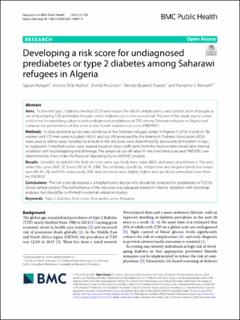| dc.contributor.author | Henjum, Sigrun | |
| dc.contributor.author | Hjellset, Victoria Telle | |
| dc.contributor.author | Andersen, Eivind | |
| dc.contributor.author | Flaaten, Merethe Øyaland | |
| dc.date.accessioned | 2022-04-21T10:21:27Z | |
| dc.date.available | 2022-04-21T10:21:27Z | |
| dc.date.created | 2022-04-20T09:32:19Z | |
| dc.date.issued | 2022 | |
| dc.identifier.citation | Henjum, S., Hjellset, V. T., Andersen, E., Flaaten, M. Ø. & Morseth, M. S. (2022). Developing a risk score for undiagnosed prediabetes or type 2 diabetes among Saharawi refugees in Algeria. BMC Public Health, 22(1), Artikkel 720. | en_US |
| dc.identifier.issn | 1471-2458 | |
| dc.identifier.uri | https://hdl.handle.net/11250/2991906 | |
| dc.description.abstract | Aims: To prevent type 2 diabetes mellitus (T2D) and reduce the risk of complications, early identification of people at risk of developing T2D, preferably through simple diabetes risk scores, is essential. The aim of this study was to create a risk score for identifying subjects with undiagnosed prediabetes or T2D among Saharawi refugees in Algeria and compare the performance of this score to the Finnish diabetes risk score (FINDRISC).
Methods: A cross-sectional survey was carried out in five Saharawi refugee camps in Algeria in 2014. A total of 180 women and 175 men were included. HbA1c and cut-offs proposed by the American Diabetes Association (ADA) were used to define cases. Variables to include in the risk score were determined by backwards elimination in logistic regression. Simplified scores were created based on beta coefficients from the multivariable model after internal validation with bootstrapping and shrinkage. The empirical cut-off value for the simplified score and FINDRISC was determined by Area Under the Receiver Operating Curve (AUROC) analysis.
Results: Variables included in the final risk score were age, body mass index (BMI), and waist circumference. The area under the curve (AUC) (C.I) was 0.82 (0.76, 0.88). The sensitivity, specificity, and positive and negative predictive values were 89, 65, 28, and 97%, respectively. AUC and sensitivity were slightly higher and specificity somewhat lower than for FINDRISC.
Conclusions: The risk score developed is a helpful tool to decide who should be screened for prediabetes or T2D by blood sample analysis. The performance of the risk score was adequate based on internal validation with bootstrap analyses, but should be confirmed in external validation studies. | en_US |
| dc.language.iso | eng | en_US |
| dc.rights | Navngivelse 4.0 Internasjonal | * |
| dc.rights.uri | http://creativecommons.org/licenses/by/4.0/deed.no | * |
| dc.title | Developing a risk score for undiagnosed prediabetes or type 2 diabetes among Saharawi refugees in Algeria | en_US |
| dc.title.alternative | Developing a risk score for undiagnosed prediabetes or type 2 diabetes among Saharawi refugees in Algeria | en_US |
| dc.type | Peer reviewed | en_US |
| dc.type | Journal article | en_US |
| dc.description.version | publishedVersion | en_US |
| dc.rights.holder | © The Author(s) 2022. | en_US |
| dc.source.volume | 22 | en_US |
| dc.source.journal | BMC Public Health | en_US |
| dc.source.issue | 1 | en_US |
| dc.identifier.doi | https://doi.org/10.1186/s12889-022-13007-0 | |
| dc.identifier.cristin | 2017756 | |
| dc.source.articlenumber | 720 | en_US |
| cristin.ispublished | true | |
| cristin.fulltext | postprint | |
| cristin.qualitycode | 1 | |

